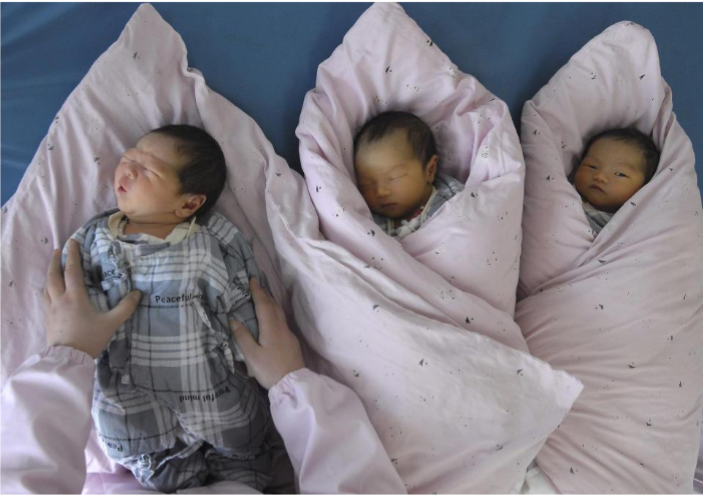Three-Child China
Author: Angelica Hill

In late May this year, the Chinese government announced the abolishment of the Two-Child Policy in favor of the Three-Child Policy. The revised policy was met with lukewarm reception from many Chinese, who find it is too expensive to raise one child, much less three, in the current economic conditions. The Three-Child Policy is the latest bid to raise China’s falling birthrates caused in part by the original One-Child Policy and the country’s rapid development, but will it be enough to stop the decline?
When the highly controversial One-Child Policy was introduced to China in 1980, it was the most widespread population control policy in modern history. Limiting most Chinese couples to only one child, the family-planning mandate contrasted the Great Leap Forward’s desires for population growth and sought to avoid a predicted overpopulation crisis. It was very successful, reducing the fertility rate from 2.74 births per woman in 1979 to 1.6 births in 2000, but the policy also reduced the Total Fertility Rate beneath the replacement level of 2.1 births. This means that, over time, China’s population will decrease as women will not give birth to enough children to replace themselves and their partners in the next generation. Similar drops have occurred in nations without such family planning policies, indicating that the One-Child Policy alone did not cause this. Increasing female education levels, decreasing infant mortality rates, and access to birth control, all positive factors indicative of a country’s development, have been shown to lower fertility rates. The One-Child Policy also gave rise to the “4-2-1 Problem”, referencing the family structure that will leave one child to care for both their parents and their four grandparents. This is part of a larger demographic imbalance issue caused by the sudden change to the One-Child Policy, which leaves a smaller younger generation to care economically and socially for the larger older generations.
In 2016, the Two-Child Policy was put into effect to solve many of these issues, but its efficacy was questionable. Instead of producing the expected “baby bump” in birth rates, the number of births fell after the first year of the policy. In 2018, births were at their lowest since 1960, with 15.6 million births compared to 2016’s 17.9 million. Birth rates still failed to meet replacement levels, at 1.69 births per woman in 2018. Critics also condemned the policy, saying that the expenses of raising children in China are far too high and that increasing the quota of children per family would demote women to a child-bearing role. Some women have reported discrimination from their employers, who reportedly fired pregnant women or asked new hires to sign contracts stating they would not become pregnant. In 2018, reports said that authorities were working to remove population-control mandates all together, but in May 2021, the Three-Child Policy was announced. At the same time, the government vowed to lower education costs and protect the interests of women in the workplace, but still few women express interest in having more children. It is far too early to see how a Three-Child China may fare, but evidence from the Two-Child era suggests that more needs to be done to raise the country’s fertility rates.
References:
Stanway, D. & Munroe, T., 2021. Three-child policy: China lifts cap On births in major policy shift. Reuters. Available at: https://www.reuters.com/world/china/china-says-each-couple-can-have-three-children-change-policy-2021-05-31/[Accessed July 27, 2021].
Fitzpatrick, L., 2009. China’s one-child policy. Time. Available at: http://content.time.com/time/world/article/0,8599,1912861,00.html[Accessed July 28, 2021].
Anon, Fertility rate, total (births per woman) -China. The World Bank. Available at: https://data.worldbank.org/indicator/SP.DYN.TFRT.IN?name_desc=false&locations=CN[Accessed July 28, 2021].
Smoak, N., 2016. Fertility rate. EncyclopædiaBritannica. Available at: https://www.britannica.com/topic/fertility-rate[Accessed July 27, 2021].
Gallagher, J., 2020. Fertility rate: ‘jaw-dropping’ global crash in children being born. BBC News. Available at: https://www.bbc.com/news/health-53409521[Accessed July 28, 2021].
Nargund, G., 2009. Declining birth rate in Developed Countries: A radical policy re-think is required. Facts, views & vision in ObGyn, 1(3), 191–193.
Bailey, D., Ruddy, M. & Shchukina, M., 2012. Ageing china: Changes and challenges. BBC News. Available at: https://www.bbc.co.uk/news/world-asia-19630110[Accessed July 27, 2021].
Fong, M., 2021. Chinese women have already voted Against BEIJING’S Natalist Hopes. Foreign Policy. Available at: https://foreignpolicy.com/2021/06/04/china-women-two-child-policy-birth-rates/[Accessed July 28, 2021].
Textor, C., 2021. Number of births per year in China from 2010 to 2020. Statista. Available at: https://www.statista.com/statistics/250650/number-of-births-in-china/[Accessed July 28, 2021].
Anon, Fertility rate, total (births per woman) -China